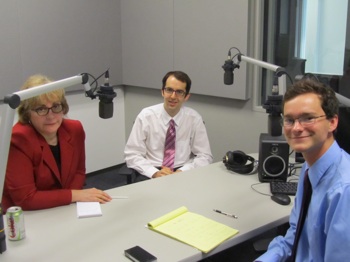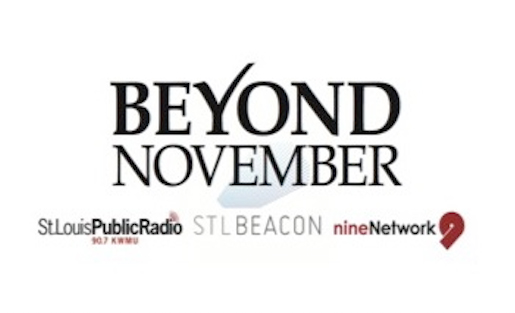Correction: The Twitter hashtag for Beyond November is #beyondnov, not #beyondnovember as a previous version of this post stated.
In St. Louis, three non-profit news organizations — St. Louis Public Radio (SLPR), the Nine Network of Public Media and the St. Louis Beacon — have joined forces to produce election coverage through a project called Beyond November. Their hope, as the name implies, is to keep the project going after the election is over, at which point coverage would focus on holding elected officials accountable; the partners are currently fundraising toward that goal. (Beyond November is currently funded by a $200,000 grant from the Deer Creek Foundation.)

In the meantime, on October 8, SLPR and the Beacon announced their intent to explore a larger journalism alliance. When I spoke to Margaret Wolf Freivogel, editor at the Beacon and one of its founders, she explained that Beyond November wasn’t exactly the catalyst for this alliance — rather, the idea had been “in the wind” ever since the Beacon launched five years ago, and gained momentum recently thanks to conversations between the the chairman of the Beacon board, Richard K. Weil Jr., and SLPR general manager Tim Eby.
Still, Beyond November offers a window into what editorial collaboration between these organizations might look like (with the added participation, in this case, of the Nine Network). Here’s how Beyond November works, at a glance.
Staffing: Dedicated Managing Editor and Radio Reporter
One of the partners’ first moves was appointing Dick Weiss, a veteran St. Louis journalist, as the project’s full-time managing editor. Weiss was a reporter for the St. Louis Post-Dispatch for 30 years and helped found the Beacon, where he was working part-time when the opportunity to be Beyond November’s dedicated managing editor arose.

In addition to Weiss, the partners hired a dedicated radio reporter to work on the project, Chris McDaniel, who works out of the SLPR newsroom. McDaniel works closely with news director Bill Raack, as well as with Weiss and with other political reporters at SLPR and the Beacon. McDaniel frequently participates in SLPR’s Politically Speaking podcast with Beacon reporters.
Throughout the day, the partners co-publish their election coverage on their own websites; summaries appear on the Beyond November site, with links to the full stories. Weiss also publishes original content exclusive to Beyond November, like the Back Fence series (inspired by The Conversation on the New York Times site) in which citizens with different positions agree to have an email conversation about an issue and the dialogue is published.
Weiss determines what shows up on Beyond November, though he hired a web manager to assist with homepage management, so he doesn’t have to be “glued to his computer” all day — giving him more time to work with reporters to plan coverage, and to serve as the project’s ambassador out in the community.
A Day in the Life
On the day we spoke by phone, Weiss’s schedule looked something like this:
- Visit the site around 6am. Possibly rearrange story lineup or edit story summaries before daily email goes to subscribers at 9am.
- Arrive at the office by 9am (he has a desk at SLPR and at the Nine Network). “Cruise around,” talking to reporters; the focus is often on how the partners can best create complementary versus redundant coverage. (These conversations are in addition to a formal weekly editorial meeting.)
- Work on a summary of project accomplishments to date to help with fundraising efforts.
- Work on special projects, like The Back Fence, or planning how to best showcase video from a recent debate (for example, allowing users to navigate by the question the moderator asked).
Weiss also markets Beyond November actively, attending events around town armed with cards promoting the project and inviting people to sign up for the site’s daily email. (There are currently around 1,000 subscribers.)
Building an Audience

In a phone conversation, Raack conceded that it’s been slow going to build traffic to the site. I can empathize, having managed another public media news collaboration that involved launching a new brand and website — it takes a significant amount of time and an unrelenting marketing effort to build an audience for a new news property. In this case, the partners are lucky in that they can leverage their airwaves to build awareness, and they do — promoting Beyond November at the end of related radio stories and in television interstitials; plus, the site is prominently featured and linked from each partner’s homepage. In addition, the #beyondnov hashtag is designed to help raise awareness of the project via social media.

The project’s biggest promotional boost may be thanks to Todd Akin, who increased national interest in Missouri politics. “Todd Akin was very helpful to us,” Weiss told me. “Every time he said something it would drive some traffic and create some interest.”
While traffic may not yet be where the partners would like it to be, Weiss thinks people who follow public media in St. Louis are aware of the project. It remains to be seen whether traffic will grow in the weeks leading up to election day. Certainly, the site’s prospects seem stronger if Beyond November can be part of a larger journalism partnership between SLPR and the Beacon, one that becomes part and parcel of how local residents get their news.
Are you aware of similar election-related news partnerships in other cities? What are other examples of nonprofit news orgs coming together to cover local and national races?
Correction: The Twitter hashtag for Beyond November is #beyondnov, not #beyondnovember as a previous version of this post stated.
Amanda Hirsch is the editor of Collaboration Central. She is also a writer, performer and social media strategist who lives in Brooklyn, N.Y. The former editorial director of PBS.org, she blogs at amandahirsch.com and spends way too much time on Twitter.

